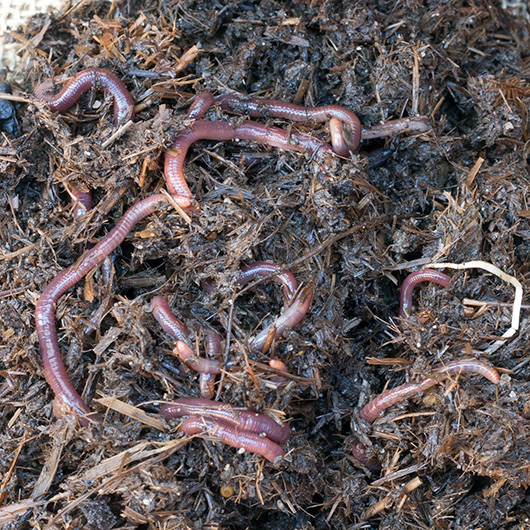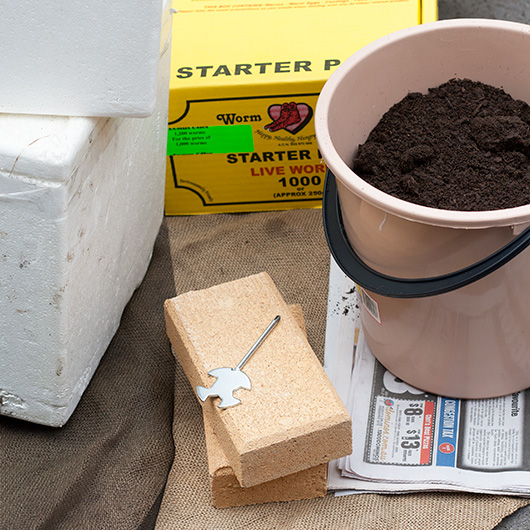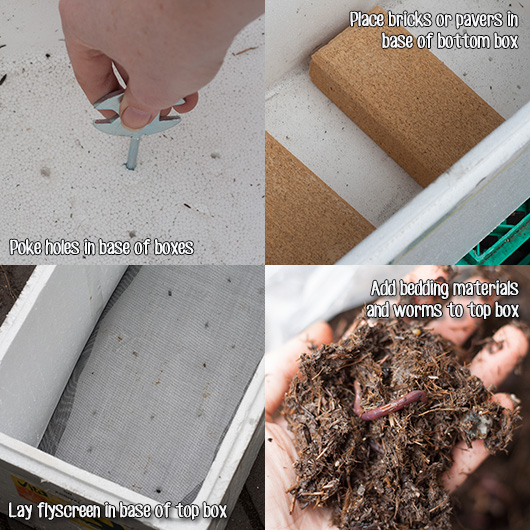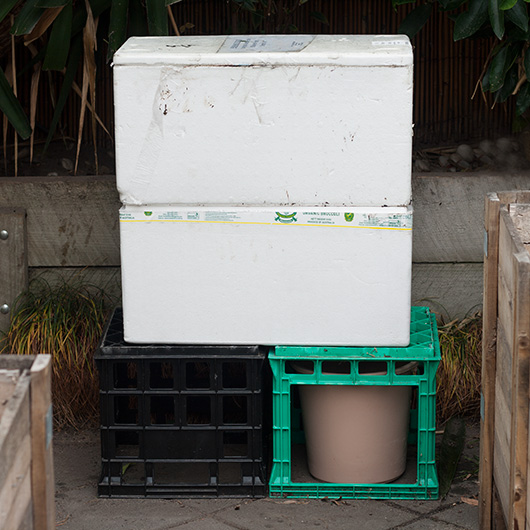Wriggly, squiggly, squishy, messy worms. Whether you love them or they make you squeamish, worm farming is one of the most rewarding gardening activities for improving the health and harvest of your garden.

Why you want to make a worm farm
A worm farm is the most simple way to turn your household food waste into amazing, nutrient-rich garden fertiliser. With minimal effort you get not one but two fantastic natural fertilisers – “worm tea” fertiliser and worm poo (vermicast) that can be used as garden compost. Worms will happily eat most of your kitchen waste (no citrus, onions or meat please!) and in return you can turn around any issues of poor garden yield and depleted soils. It’s also a much faster return for your garden than traditional compost bins or open compost piles.
There are also fantastic benefits for the environment. Worm farming is an excellent way to recycle waste that would otherwise be contributing to greenhouse gas production in landfills. In addition to this, Australian soils in particular are very mineral depleted and infertile; worm farming helps to return essential nutrients and organic materials (humus) to the soil while helping increase water holding capacity and aeration. Our household organic waste should never end up in landfill when there is so much more we can do to recycle it.
Why you should DIY it, instead of buy it
I’ve spent a good few months looking at worm farm products and I can tell you they are really expensive! It’s easily $80-120 for some of the free standing, pre-made units, $20 for a worm blanked to cover them with, then $50-80 for compost worms. I’m frugal, I didn’t want to part with that much cash. Luckily then this DIY adventure gives you a big payoff for little investment of your money or time.
Choosing to make your own worm farm will cost around $20 in materials, depending where you get your supplies from and what you already have on hand. Your compost worms are your highest investment and the price will vary on where you source them from and how many you start with.

Things You’ll Need
- 2 polysterene broccoli boxes (or similar), 1 with lid, 1 without
Be prepared to get cosy with your local greengrocer or supermarket produce manager to complete this task. While polysterene in landfill is bad for the environment because it breaks down incredibly slowly, for your worm farm it’s a useful choice as it is strong, light and insulating for your heat-sensitive wormies. - 2 bricks OR 2 tiles
- 2 empty milk crates
- A piece of fly screen big enough to cover bottom of edge of one box
- Screwdriver, long nail or other strong pointed implement
- 2 old newspapers – 1 loosely hand shredded
- Water
- Bucket-full of well rotted compost OR garden soil/potting mix
- 1 large plastic jug or bucket
- Minimum of 1000 compost worms
This could be the most expensive part of the project, depending where you buy them from. You can’t just pull up earthworms from the garden either. While earthworms are specialised at building great soil structure, compost worms voraciously want to eat all your scraps. Find compost worms (including a mix of Reds, Blues and Tigers) at gardening centers, Bunnings stores, on Ebay, Gumtree or Craigslist.

Instructions
- Place milk crates side-by-side in a shady, sheltered area.
- Using screwdriver, nail or other sharp instrument, poke 1 or 2 holes in the bottom of one of the polysterene containers. Sit atop milk crates and place bricks or tiles inside of this container – this will weigh down the worm farm and prevent the drowning of any worms that fall through the top container by giving them a structure to climb up.
- Place the plastic jug or bucket under the holes you poked to collect liquid worm wee for home-made fertiliser.
- Poke several holes all over the bottom of second polysterene containers and lay piece of flyscreen on bottom of this box.
- Add shredded, soaked newspaper and compost/potting mix and mix well to combine. Pour on enough water to create a moist (not wet!) bedding material. If in doubt grab a handful and squeeze, if a little water comes out then stop watering.
- Add your worms into the top container and then add a small amount of food scraps. While your worms are settling into their new home they won’t be particularly hungry, so take it easy for a couple of weeks. Feed a little and often, as long as you can see the food is being eaten (see What to Feed Your Worms and What Not to Feed Your Worms below). Eventually they will eat up to 1kg of scraps a day for every 1kg of worms you have.
- Place the whole, soaked newspaper on top of the food scraps to keep the worm farm damp and dark, then place the container lid on top. You can place one more brick on top to weigh the lid down if you like.

Ok, now what?
The hard part of this easy project is over, stand back and take in the amazing worm farm you’ve created. From this point all you need to do is periodically check on the farm for 3 important things:
- Make sure the bedding is damp but not wet – if it is soaking wet your worms won’t be able to breathe. Check the bottom box to see if any wily worms have discovered a way to escape – then put them back in their bedding.
- Check that the worms are eating the food you have previously given them- do not overfeed if they aren’t clearing food away.
- Collect the precious vermicasts and worm wee for use in your garden – more to come in another post!
What to Feed Your Worms
- All fruit and vegetable wastes (except onions and citrus)
- Bread and grains (in small amounts)
- Egg shells
- Hair
- Dust from vacuum cleaners
- Leaves and grass clippings
- Used tea bags, coffee grounds and filters
- Paper products – newspaper, cardboard, paper napkins etc. as long as they have been ripped up and thoroughly soaked
What Not to Feed Your Worms
- Onion plants – onions, leeks, spring onions, garlic
- Citrus fruits – lemons, limes, oranges etc.
- Meat or dairy products
- Sticks or branches (but leaves are fine)
- Pet faeces (unless you have a separate in-ground worm farm specifically for them). While you should never use worm castings from a pet waste worm farm on your edible plants it is safe to use on ornamentals.

Comments 4
Hello Ally,
congratulations on your excellent article! I love cheap and affordable worm farms because I think every household should have at least one worm farm to help themselves as well as the environment!
I have several plans for different worm farms on my website and one of them is probably the cheapest worm farm in the world! You will find the website link attached to this comment!!
Keep up your great work!
Happy gardening and happy worming!
best regards
Stephan
Author
Thanks for the comment Stephan, I agree that every household would benefit from a worm farm and hope that everyone who reads this article and the comments gets even more inspiration from your website!
Happy worming and thanks for stopping by 😀
I can’t wait to try this, Ally! Thank you; it’s an awesome tutorial!
Liz, Wilmington, NC, USA
Author
My pleasure Liz! Thanks for leaving a comment 🙂 when I get home from work I’m looking forward to checking out your website!